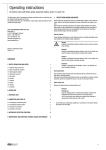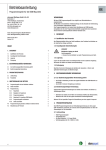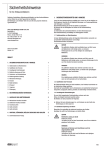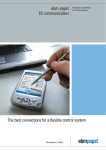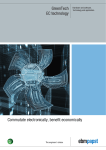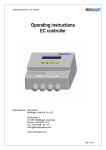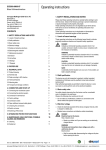Download Operating instructions
Transcript
Operating instructions for built-in fans with size 110 and 138 motors The device type, date of manufacture (calendar week/year) and the conformity sign are located on the nameplate on the fan. For questions about the fan or the delivery of spare parts, please provide the entire content of the nameplate. ebm-papst Mulfingen GmbH & Co. KG Bachmühle 2 D-74673 Mulfingen, Germany Tel.: +49-7938-81-0 Fax: +49-7938-81-110 [email protected] www.ebmpapst.com Please read these operating instructions carefully before starting to work with the device. Observe the following warnings to prevent malfunctions or danger to persons. Ensure that the operating instructions are always readily available at the device. If the device is sold or transferred, the operating instructions must accompany it. These operating instructions may be duplicated and forwarded for information about potential dangers and their prevention. Symbols used These operating instructions use the following symbols to indicate potentially hazardous situations and important safety regulations: Danger! Indicates a potentially hazardous situation, which, if not avoided, could constitute a risk for life and limb. Exercise extreme caution while working. Revised: 19 September 2007 Version 1.0 Warning! Indicates a potentially hazardous situation, which, if not avoided, can result in injuries. Exercise extreme caution while working. Caution! Indicates a potentially hazardous situation, which, if not avoided, can result in minor injuries or property damage. CONTENTS 1. SAFETY REGULATIONS AND NOTES 2 1.1 Electrical voltage and current 1.2 Safety and protective functions 1.3 Electromagnetic radiation 1.4 Mechanical movement 1.5 Hot surface 1.6 Emission 1.7 Transport 1.8 Storage 1.9 Cleaning 1.10 Disposal 2 2 2 2 2 2 3 3 3 3 2. PROPER USE 3 3. TECHNICAL DATA 3 4. CONNECTION AND START-UP 4 4.1 4.2 4.3 4.4 4.5 4.6 4.7 4.8 4 4 4 7 7 7 7 7 Connecting the mechanical system Connecting the electrical system Connection in terminal box Connection via wires from stator bush Motor protection Connecting up several devices Checking the connections Switching on the device 1. SAFETY REGULATIONS AND NOTES 5. MAINTENANCE, MALFUNCTIONS, POSSIBLE CAUSES AND REMEDIES 7 5.1 Safety examination 7 Attention! Indicates a potentially harmful situation, which, if not avoided, can result in property damage. Staff qualification Only specialised electrical personnel may install the device, perform the test run and work on electrical system. Only trained and authorised specialist personnel are permitted to transport, unpack, assemble, operate or maintain the device, or to use it in any other manner. Basic safety rules Observe the following when working with the unit: Warning! Rotating fan Long hair, dangling items of clothing and jewellery could become entangled and be pulled into the device. You could be injured. ➜ Do not wear any loose clothing or jewellery while working on moving parts. Protect long hair with a hood. – Do not make any modifications, additions or conversions to the device without the approval of ebm-papst. 1 1.1 Electrical voltage and current 1.7 Transport Check the electrical equipment of the device at regular intervals. Remove loose connections and defective cables immediately. Caution! Transport of fan Cutting and crushing hazard ➜ Wear safety shoes and cut-resistant safety gloves. Transport the fan in its original packaging only. The vibration values listed in the technical data must not be exceeded during the entire transport. Secure the fan so that it does not slip, for example using a lashing strap. 1.2 Safety and protective functions Danger! Missing safety device and non-functioning protective features Risk of fatal injury ➜ Shut down the device immediately if you detect a missing or ineffective protective feature. The device is an installation item that has no function on its own. As the operator, you are responsible for ensuring that the device is adequately secured. 1.3 Electromagnetic radiation Interference from electromagnetic radiation is possible, e.g. in conjunction with open and closed-loop control devices. If unacceptable emission intensities occur when the fan is installed, suitable shielding measures must be taken before the device is commissioned. 1.4 Mechanical movement Danger! Rotating fan Body parts that come into contact with the fan while it is rotating can be injured. ➜ Secure the fan to prevent contact. Before working on the installation/machine, wait until all parts have come to a standstill. Warning! Ejected parts in the exhaust zone Danger of injury In the event of a fault, balancing weights or broken fan blades may be ejected. ➜ Take appropriate safety measures. Do not stay in the exhaust zone. Caution! Self-starting fan Danger of injury The motor automatically restarts when voltage is applied, for example after a power failure an. ➜ Do not stay in the danger area of the fan. When working on the fan, switch off the mains supply voltage and secure it from being switched on again. 1.5 Hot surface Caution! High temperature at the motor housing Danger of burn injuries ➜ Ensure that sufficient protection against accidental contact is provided. 1.6 Emission Warning! Depending on the installation and operating conditions, a sound pressure level greater than 70 dB(A) can arise. Danger of noise-induced hearing loss ➜ Take appropriate technical safety measures. Safeguard the operating personnel with appropriate protection measures, e.g. ear protectors. 2 1.8 Storage Store the device in a dry place, where it is protected in a clean environment. Keep to the specified storage temperatures, please refer to Chapter 3, Technical data. If the device is shut down for some time, you are advised to run the device once a month for about 15 minutes to move the bearings. 1.9 Cleaning Attention! Damage to the device during cleaning. Malfunction possible ➜ Do not clean the device using a water jet or high-pressure washer. Do not use any cleaners containing acids, bases or solvents. 1.10 Disposal When disposing of the device, please comply with all relevant requirements and regulations applicable in your country. 2. PROPER USE 4. CONNECTION AND START-UP The device is designed exclusively as built-in fan for moving air according to the technical data. Any other or secondary use is deemed improper use and a misuse of the device. Installations necessary on the part of the commissioning party must meet the mechanical, thermal and service life-related stresses that can occur. 4.1 Connecting the mechanical system Install the device according to your application. Use the device according to its moisture class. Caution! Proper use also includes: – Operating the device with all protective features. – Observing the operating instructions. – Use of the device in accordance with the permissible ambient temperature, see Chapter 3 "Technical data". Cutting and crushing hazard when removing the fan from the packaging ➜ Carefully lift the device out of the packing at using inside area of the blades (axial fan) or the impeller (radial fan). Be certain to avoid any shock. Wear safety shoes and cut-resistant safety gloves. Two people should lift the device out of its packaging if it is heavier than 10 kg. Improper use In particular, the following uses of the fan are prohibited and can lead to dangerous situations: – – – – – – – – – Moving air that contains abrasive particles. Moving highly corrosive air. Moving air that contains dust pollution, e.g. suctioning off saw shavings. Using the fan to move flammable gases/particles. Operating the fan in the vicinity of flammable materials or components. Operating the fan in an explosive atmosphere. Using the fan as a safety component or for taking on safety-related functions. Operation in medical equipment with a life-sustaining or lifesaving function. Operation in non-stationary installations such as railroad vehicles, aircraft and spacecraft. – Operation with completely or partially disassembled or modified protective features. – Operation with external vibrations that exceed the permissible vibration load. – In addition, all application options that are not listed under proper use. If you have specific questions, contact ebm-papst for support. 3. TECHNICAL DATA Additional device-specific data are available upon request from ebm-papst. Hot motor housing Danger of fire ➜ Ensure that no combustible or flammable materials are located in the vicinity of the fan. 4.2 Connecting the electrical system The connection to the electrical system is made after the connection to the mechanical system. – Before connecting the device, ensure that the mains supply voltage matches the fan voltage. – Check whether the data on the nameplate agree with the connection data and the data of the operating capacitor (single-phase motors only). – Only use cables that are configured for current according to the type plate. Danger! Incorrect insulation Risk of fatal injury from electric shock ➜ Use only cables that meet the specified installation requirements for voltage, current, insulation material, load etc. 4.3 Connection in terminal box (valid for axial fans) Mounting data Stripping connecting cables The following must be observed: – – – Warning! Tightening torque of the screwed cable gland: 2.0 Nm Tightening torque of mounting screws of terminal box cover: 0.8 Nm Property class of mounting screws: 8.8 Strip the cable just enough so that the screwed cable gland is tight and the terminals are relieved of strain (for tightening torques, refer to Chapter 3 "Technical data"). Ambient conditions Permitted ambient temperature for motor Transport & storage Operation -40 °C to +80 °C -25 °C...+40 °C (60 °C) Resistance to vibrations 1 g (acc. to IEC 60068-2-6) min. 5 mm 50 0.5 g (acc. to IEC 60068-2-6) TW1, TW2 L1, L2, L3, and/or L, N 6 Protective earth 6 60 Figure 1: Recommended stripping lengths in mm (inside the terminal box) 3 Connecting cables with terminals Caution! Electrical voltage The fan is a built-in component and features no electrically isolating switch. ➜ Only connect the fan to circuits that can be switched off with an all-pole separating switch. When working on the fan, you must switch off the installation/machine in which the fan is installed and secure it from being switched on again. No water may penetrate along the cable in the direction of the cable gland. The cable must be relieved of strain. Mounting position of fan: shaft vertical, rotor at bottom Ensure that the cable is routed in the form of a loop ("water trap" see Figure 5). – Open the terminal box. – Open the screwed cable gland. Axial fans with size 110 motors Axial fans with size 138 motors are supplied with a sealing cap and insert for cables with Ø 6 - 12 mm, see Fig. 2. are supplied with a sealing cap and insert for cables with Ø 7 - 14 mm, see Fig. 2. – Remove the cap, see figure 3. – Guide the cable through the cable gland Figure 5: Fan installed lying flat (shaft vertical, rotor on bottom), cable routed as "water trap" Mounting position: shaft horizontal When routing cables, ensure that the screwed cable glands are arranged at the bottom, see Figure 6. The cables must always be routed downwards. Figure 2. Screwed cable gland with cap Figure 3. Cap removed 180° – Connect up the protective earth (PE) wire. – Connect the remaining leads to the respective terminals. See Fig. 4. – Connect up the thermal overload protector (T.O.P.) an. During the connection work, ensure that no cables splice off. 180° Figure 6: Cable routing for upright built-in fans (shaft horizontal) Interface diagram - single-phase capacitor motor C Figure 4: Connecting the wires to terminals The terminal strip is equipped with a penetration prevention device. – Insert the strands until they meet resistance. There must be no voltage applied between the terminal and the cable gland. The cable must be relieved of strain. Terminal area single-strand up to 4 mm² fine-strand up to 2.5 mm² 4 U1 = blue U2 = black U1 Z U2 L TW TW N PE Fig. 7: Single-phase capacitor motor with thermal overload protector Z= brown PE = green/yellow TW = grey Interface diagram - three-phase motor 4.4 Connection via wires from stator bush (valid for centrifugal fans) U1 V1 W1 W2 U2 V2 TW TW L1 L2 L3 U1 = black PE Fig. 8: Star connection with thermal overload protector U2 = green V1 = blue V2 = white W1 = brown Motor size Cable length* 110 800 mm 138 1000 mm Connect up the wires according to your application. Stripping connecting cables* TOP1, TOP2 W2 = yellow Wires (L1, L2, L3, and L, N) PE = green/yellow U1 V1 W1 W2 U2 V2 TW TW Protective earth L1 L2 L3 PE 6 85 Fig. 9: Delta connection with thermal overload protector With single-phase motors, make sure that the capacitors are also connected. Reverse direction of rotation by interchanging two phases. 4.5 Motor protection Interface diagram - single-phase capacitor motor N PE L C TOP U2 Z U1 U1 = U2 = Z= PE = TW = blue black brown green/yellow grey Interface diagram - three-phase motor L1 U1 L2 V1 L3 Danger! Lack of motor protection The motor becomes hot. Body parts that come into contact with the motor can be injured. ➜ Connect up the thermal overload protector installed in the coil. Wire the freed thermal overload protectors in the control current circuit so that no automatic switch-on can occur after cooling down following a malfunction. Fig. 10: Single-phase capacitor motor with thermal overload protector PE The motors are equipped with thermal overload protectors to protect the devices. Check to make sure that the thermal overload protector is correctly connected before each operation. Failure to correctly connect up the thermal overload protector will invalidate defect warranty cover. TOP W1 U1 = black U2 V2 U2 = green W2 Fig. 11: Star connection with thermal overload protector L1 PE L2 L3 TOP V1 = blue V2 = white W1 = brown V1 U2 V2 W1 W2 Fig. 12: Delta connection with thermal overload protector. Reverse direction of rotation by interchanging two phases Fig 14: Interface diagram motor protecting switch, single-phase W2 = yellow PE = green/yellow U1 Fig 13: Interface diagram motor protecting switch, three-phase Attention! Lack of motor protection The motor becomes too hot and thus suffers damage. The motor is not switched on automatically. ➜ Locate the source of the error and eliminate the error. Connect up the thermal overload protector installed in the coil. Voltage control With open loop speed control using transformers or electronic voltage regulators (e.g. phase control), excessive current may occur. In addition, noises can occur with phase control, depending on the manner in which the device is installed. * Customer-specific differences possible 5 Frequency inverter Fit sinusoidal filters that work on all poles (live-live and live-earth) between the frequency inverter and the motor for operation with frequency inverters. 4.6 Connecting up several devices 5. MAINTENANCE, MALFUNCTIONS, POSSIBLE CAUSES AND REMEDIES Malfunction/error Possible cause Possible remedy Motor does not turn Mechanical blockage Switch off, de-energise, and remove mechanical blockage Mains supply voltage faulty Check mains supply voltage, restore power supply If you intend to connect up more than one device, you may use the second screw hole on the terminal box to route another wire. Faulty connection Correct connection, see connection configuration Thermal overload protec- Allow engine to cool off, locate tor responded and rectify cause of error, if necessary cancel switch-on inhibitor Warning! Electric voltage on cable gland Electric shock ➜ Do not use plastic terminal boxes with metal cable glands. – Screw the cable gland (size M20) into the pre-cut thread a spanner. Note the specified tightening torques, please refer to Chapter 3 , Technical data. – Remove the plastic tab that has become lose when the wire is pressed through into the terminal box. Overtemperature of Ambient temperature too motor high If possible, reduce ambient temperature Insufficient cooling Improve cooling Unacceptable operating point Examine operating point, e.g. reduce throttle resistance on axial fan If you have any other problems, contact ebm-papst. 5.1 Safety examination When connecting, note Chapter 4.2, Connecting the electrical system and Chapter 4.3, Connection in terminal box. 4.7 Checking the connections How to test? Frequency Contact prevention clothing Visual inspection at least every 6 months Fan for damage Visual inspection at least every 6 months Danger! Mounting of fan Visual inspection at least every 6 months Electric voltage on the device Electric shock ➜ Always install an earth wire. Check the protective earth. Mounting of connecting cables Visual inspection at least every 6 months Mounting of protective earth connection Visual inspection at least every 6 months Insulation of the cables Visual inspection at least every 6 months Tightness of screwed cable gland (only with connection via terminal box) Visual inspection at least every 6 months Condensate discharge hole against blockage Visual inspection at least every 6 months Make sure the power is off. Secure it from being switched on again. – – – – Check the correct fit of the connecting cables. Fasten the screwed cable gland again. Ensure that the cable gland is securely tightened. Tighten the cable gland enough to ensure that water cannot ingress. Refer to Chapter 3, "Mounting data" section, for the maximum tightening torque – Fasten the terminal box again. Refer to Chapter 3, "Mounting data" section, for the maximum tightening torque Make sure that the terminal box is correctly closed and sealed after completing the work and that all screws are properly tightened. Residual current operated device Only universal (type B) RCD protective devices are permitted. Like frequency inverters, RCD protective devices cannot provide personal safety while operating the device. 4.8 Switching on the device Inspect the device for visible external damage and the proper function of the protective features before switching it on. 6 What has to be tested?






